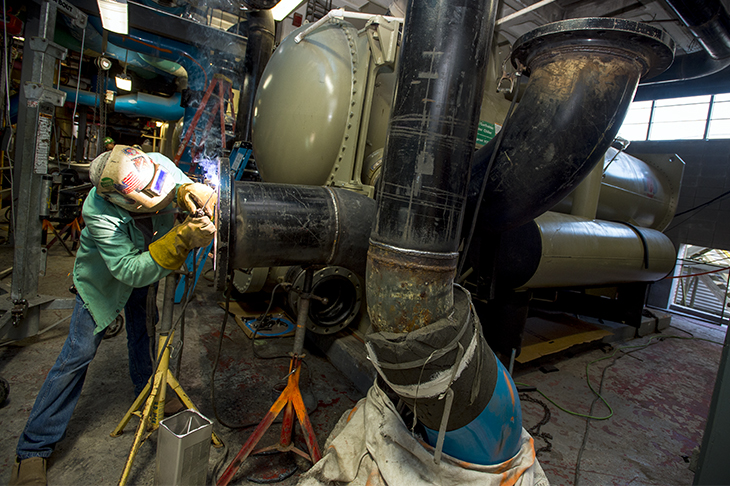On the way to being free of ozone-depleting chemicals

Installation of new 1,600-ton chillers on the uptown campus is the final step in removing all ozone-depleting chemicals from university processes. (Photo by Paula Burch-Celentano)
The replacement of several chillers responsible for keeping buildings on the uptown campus cool marks an environmental landmark for Tulane University.
Already under way, the replacement of two 1,600-ton chillers will be complete in January 2016 and will bring the university"s cooling system in compliance with the Leadership in Energy and Environmental Design (LEED) certification program that recognizes structures built with consideration to green building strategies and practices.
Mark Lebeau, director of plant operations for Tulane facilities services, says the machines are being replaced by larger, more efficient units that are capable of keeping up with the university"s growing population.
“The old chillers utilized an ozone-depleting refrigerant that was not compliant with the Montreal Protocol because it contained CFCs,” says Lebeau. “Once the four new chillers are in place, Tulane will be completely CFC-free.”
In addition to the perks of cleaner air, the larger systems also meet the N+1 redundancy factor, which improves the ability to run the university"s cooling system in the event of a single system or component failure.
Adolfo Girau, associate vice-president of plant operations and utilities, explains the cooling system on the uptown campus as being comprised of a sophisticated chill water infrastructure system with chillers in a central location. For example, the chill water circulating through Gibson Hall, used to cool the building, is being pumped through underground pipes from chillers located about a mile away.
“The main objective of this program is to provide efficient and reliable chill water service to our students, faculty and staff and to save money in utilities and operation,” says Girau, who notes that the action is the result of a Tulane energy committee he established to promote energy efficiency and conservation measures.
“Every dollar we as a community save, rather than spending on utilities, is a dollar we can apply toward academia,” says Girau. “That leaves more funding for improving academic programs at the university.”
